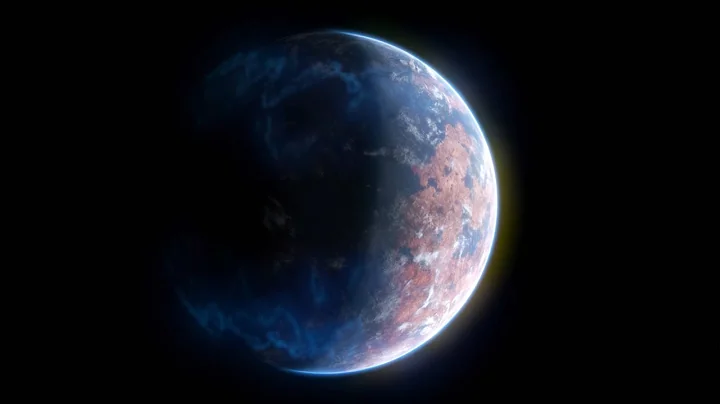Mars doesn't have tectonic plates like Earth, but it does have areas of volcanic activity that can cause rumblings, and one way to better understand Mars' mantle and core is to examine seismic activity. In March, NASA's InSight lander detected two strong, clear earthquakes originating from a location on Mars called Cerberus Fossae -- a site that had been hit earlier in the mission. There were two strong earthquakes. The and magnitudes of these earthquakes were 3.3 and 3.1 respectively; the previous earthquakes were 3.6 and 3.5 respectively.
InSight has recorded more than 1,300 earthquakes to date, but nothing like the magnitude 5 earthquake that occurred on May 4, 2022. That's a medium-sized earthquake on Earth, and they happen five times a day, but it's a scale researchers only hope to get on this mission to Mars. 
This earthquake map shows the largest earthquake ever detected on another planet. The earthquake, estimated to be a magnitude 5, was discovered by NASA's InSight lander on May 4, 2022, the mission's 1,222nd Mars day, or solar day. Credits: NASA/JPL-Caltech
This will probably be the last time you read this for a few months. As InSight's location on Mars enters winter, more dust in the air reduces the amount of sunlight available. On May 7, 2022, the lander's available energy fell just below the limit that triggered the safety mode , in which the spacecraft suspended all but the most basic functions. This reaction is intended to protect the lander and may occur again as available power slowly decreases. 
This image shows InSight's dome wind and heat shield that covers its seismometer , called the Seismic Experiment with Internal Structure, or SEIS
"Mars doesn't have tectonic plates like Earth, but it does have areas of volcanic activity that can cause rumblings, and one way to better understand Mars' mantle and core is to examine seismic activity." Related video


PLATE TECTONICS...
7:09
science Category Latest News
 science
science
Recently, under the steel structure hub overpass in Licheng District, Jinan City, Shandong Province, ragweed, known as a plant killer, appeared for the first time, which attracted the attention of the agricultural department. This is the first time that ragweed has appeared in Ji
Ragweed appears in Jinan, experts and firefighters mobilize together
07/04
1873
 science
science
It is actually a natural landscape produced by the moon, earth and sun when it is in a straight line. When the moon is blocked by the earth, it scatters when it shines on the earth, refracting the red light onto the moon and turning the moon into a red landscape. It is called a t
The wonder of the astronomical phenomena will appear on November 8th - the red moon
07/04
1694
 science
science
The elm tree is native to China. It likes light and cold, likes deep, fertile and moist soil, is not resistant to drought and is afraid of water accumulation. Therefore, the elm tree in the century is mostly north of the Jianghuai River. The king of the elm tree is in Anhui, and
The elm tree has both "materials" and has been known as the "wood king" since ancient times.
07/04
1231
![[Source: Suzhou Industrial Park Management Committee_Instant News] In the golden autumn of harvest, Jinji Lake once again ushered in the "highlight moment" of biotechnology innovation. The 2022 China Biotechnology Innovation Conference will be held on November 3, and will be held - DayDayNews](https://cdn.daydaynews.cc/wp-content/themes/begin/img/loading.gif) science
science
[Source: Suzhou Industrial Park Management Committee_Instant News] In the golden autumn of harvest, Jinji Lake once again ushered in the "highlight moment" of biotechnology innovation. The 2022 China Biotechnology Innovation Conference will be held on November 3, and will be held
The 2022 China Biotechnology Innovation Conference is held this week
07/04
1054
 science
science
It is said that the world's population of more than 7.5 billion does not have a single fingerprint. However, in our traditional Chinese culture, according to the shape of fingerprints, it is divided into two categories: vortex and flow patterns. The vortex pattern is also called
The secret of human fingerprints has been cracked by scientists, and it is actually a curse of genes. What is the secret of fighting and dustpan?
07/04
1854
 science
science
According to the results of a phase 2 trial (NCT02893917), the combination of the antiangiogenic agents sidinib and olapanib significantly improved radiographic progression-free survival (rPFS) in patients with metastatic castration-resistant prostate cancer (mCRPC) compared with
Metastatic castration-resistant prostate cancer: Targeted combinations can improve progression-free survival
07/04
1712
 science
science
On October 26 and 31, the "Snow Dragon" and "Snow Dragon" 2 polar scientific expedition ships set off one after another, sailed out of the domestic base terminal of the China Polar Research Center in Shanghai, launched a six-month scientific expedition mission, and started the 39
The meals of the Chinese Antarctic scientific expedition team in the next six months are related to this airline
07/04
1767
 science
science
Drilling and mining is a complex process that requires qualified selection and high-quality equipment debugging. Complications can occur even if all precautions are taken during the extraction of liquid minerals (such as oil). For example, in Perm, 70% of the cases, the complicat
How to prevent oil production equipment from malfunctioning
07/04
1675
 science
science
Human body freezing technology has developed technology to protect people and animals by deeply cooling the body, and is one of the promising medical fields. Research on it will not only help slow the progress of deadly diseases, but will also help future people travel in outer s
A small bug opens up a path for human space travel
07/04
1466
 science
science
Astrophysicists first observed an event that after it tore a star into pieces with tidal forces, matter near the black hole was strongly ejected. Typically, the radiative brightness emitted by the accretion disk or jet will increase almost immediately after they are replenished w
Three years ago, a star "eats" the wreckage "spouts" out of black holes
07/04
1652


















